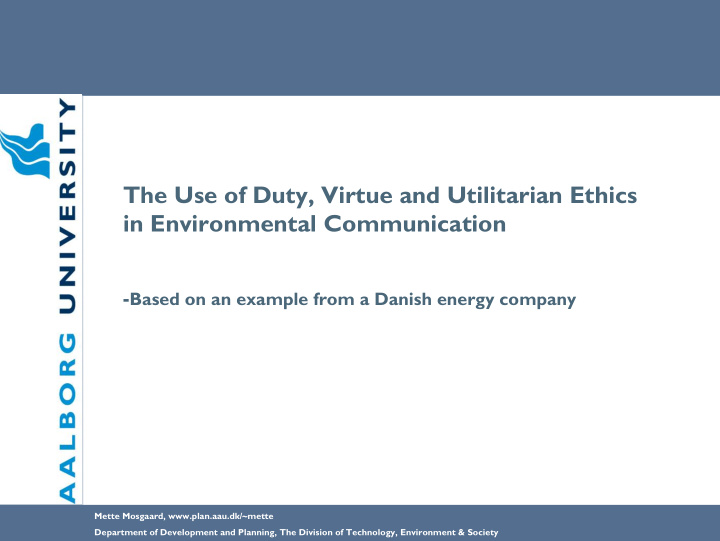



The Use of Duty, Virtue and Utilitarian Ethics in Environmental Communication - Based on an example from a Danish energy company Mette Mosgaard, www.plan.aau.dk/~mette Department of Development and Planning, The Division of Technology, Environment & Society
The context - Part of the work in an innovation consortium called CEMIP (Danish abbreviation for ”Centre for Effective Environmental Communication in Product Chains) - The companies in CEMIP: Brdr. Hartmann, Coloplast, Elsam (now DONG energy), Junckers Industries and Vestas Wind Systems - Other participants: Aalborg University, Copenhagen Business School and FORCE Technology (project manager) - Further information on: www.cemip.dk (But in Danish) Mette Mosgaard, www.plan.aau.dk/~mette Department of Development and Planning, The Division of Technology, Environment & Society
Purpose of the investigation The purpose of the investigation is to clarify the weighting of different company-related arguments used in environmental communication The arguments are divided into 3 categories: - Duty, - virtue and - utilitarian ethics Furthermore the arguments are categorized according to: - The weighting of the arguments and - The reactions associated with the absence of the arguments Mette Mosgaard, www.plan.aau.dk/~mette Department of Development and Planning, The Division of Technology, Environment & Society
Description of the categories investigated (The company values) Duty Virtue Utilitarian ethics - Compliance with -Sustainability -Positive influence on environmental regulation -Openness/ honesty environmental image - Compliance with demands in -Credibility -Give stakeholders information Goal ISO 14001 and OHSAS 18001 - Responsibility for about environmental issues environmental impacts -Economic feasibility in - employee satisfaction environmental improvements -Visibility of environmental -Visibility of environmental - Environmental cost policy and environmental goals impacts management - Have control with the -Focus on reducing -Meet expectations from environmental management environmental and health and environmentally conscious Mean system safety impacts employees -Meet demands from external - Continuous improvements -Demonstrate development relating to ISO and OHSAS - Employee involvement stakeholders (e.g. authorities) -Environmental - Environmental - Environmental communication reflects above- communication reflects communication reflects above- mentioned duty goals and above-mentioned virtue mentioned Utilitarian goals and goals and means means means Action -The environmental reports - The environmental reports - The environmental reports and green accounts are only and green accounts are and green accounts are only published as demanded in the published accessible to published on the internet regulation everyone Mette Mosgaard, www.plan.aau.dk/~mette Department of Development and Planning, The Division of Technology, Environment & Society
Elements in the questionnaire Element in questionnaire Applied scale Clarification of groups of employees. The different groups of employees Semi-closed questions that clarify the main goal, mean 0 to 4 within the categories and actions that the respondent associates with duty, value and utilitarian ethics environmental reports and green accounts. Arguments that clarify the knowledge related to environmental reports and green accounts. Ordinal scale from 0 (Strongly Arguments that clarify the attitudes towards duty, value disagree) to 4 (Strongly agree) and utilitarian issues (The elements in the presented table). Situations representing absence of duty, value and Ordinal scale from 0 (Will not utilitarian issues. The respondent is asked how he reacts notice it) to 4 (Will try to to the situation. change it) Mette Mosgaard, www.plan.aau.dk/~mette Department of Development and Planning, The Division of Technology, Environment & Society
Knowledge about green accounts and environmental reports H/R Research and development Mineral products, sales department Project department Central purchasing department Decentral environmental departments Central environmental department 0,0 1,0 2,0 3,0 4,0 Affects the development af green accounts and environmental reports Knowledge about green accounts and environmental reports Mette Mosgaard, www.plan.aau.dk/~mette Department of Development and Planning, The Division of Technology, Environment & Society
Results Virtue 4 Virtue 3 4 Absence of utilitarian 3 Duty 2 ethics Absence of utilitarian Duty 2 ethics 1 1 0 0 Absence of duty Utilitarian ethics Absence of duty Utilitarian ethics Absence of virtue Absence of virtue Average Individual results Mette Mosgaard, www.plan.aau.dk/~mette Department of Development and Planning, The Division of Technology, Environment & Society
Example - central environmental department Virtue 4 3 Absence of utilitarian ethics Duty 2 1 0 Absence of duty Utilitarian ethics Absence of virtue Mette Mosgaard, www.plan.aau.dk/~mette Department of Development and Planning, The Division of Technology, Environment & Society
Results - average for each group of employees Virtue 4,0 3,0 Absence of utilitarian ethics Duty 2,0 1,0 0,0 Absence of duty Utilitarian ethics Absence of virtue Central environmental department Decentral environmental departments Project department Mineral products, sales department Research and development H/R Mette Mosgaard, www.plan.aau.dk/~mette Department of Development and Planning, The Division of Technology, Environment & Society
Main Conclusions - The employees that react most strongly to the absence of specific issues are those responsible for preparing the environmental communication - The groups of employees included in the investigation were surprisingly well informed about the environmental issues of the company - Large differences can be found between the actions of different groups of employees to the absence of specific issues - The company now considers how to implement / distribute the company environmental values among the employees - The next step is to match the internal and external stakeholders Mette Mosgaard, www.plan.aau.dk/~mette Department of Development and Planning, The Division of Technology, Environment & Society
Recommend
More recommend